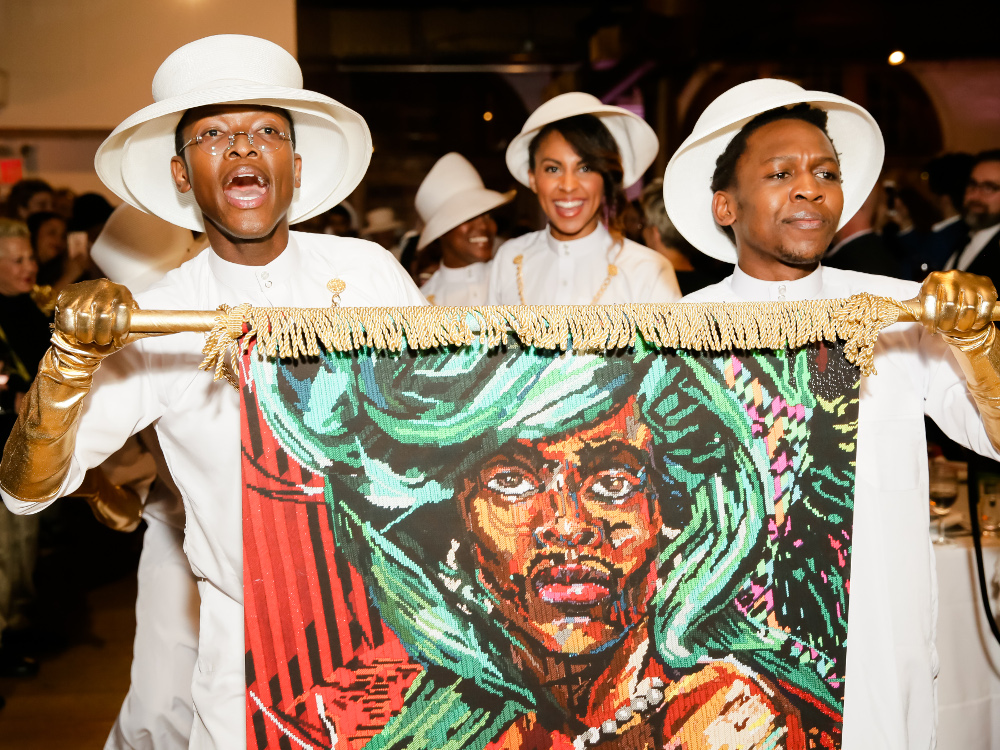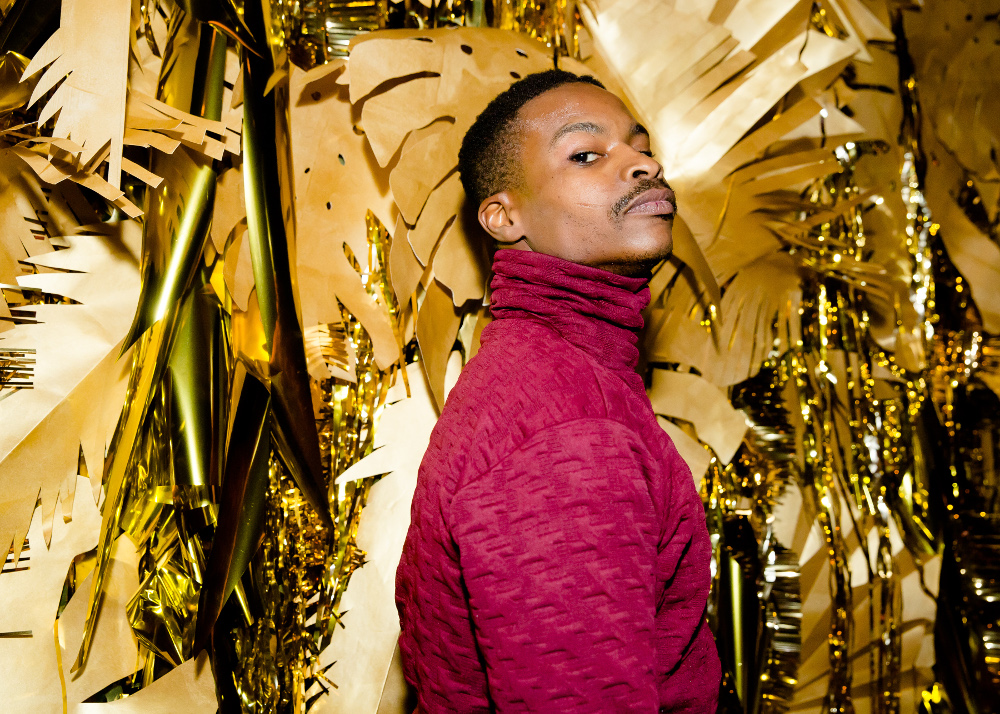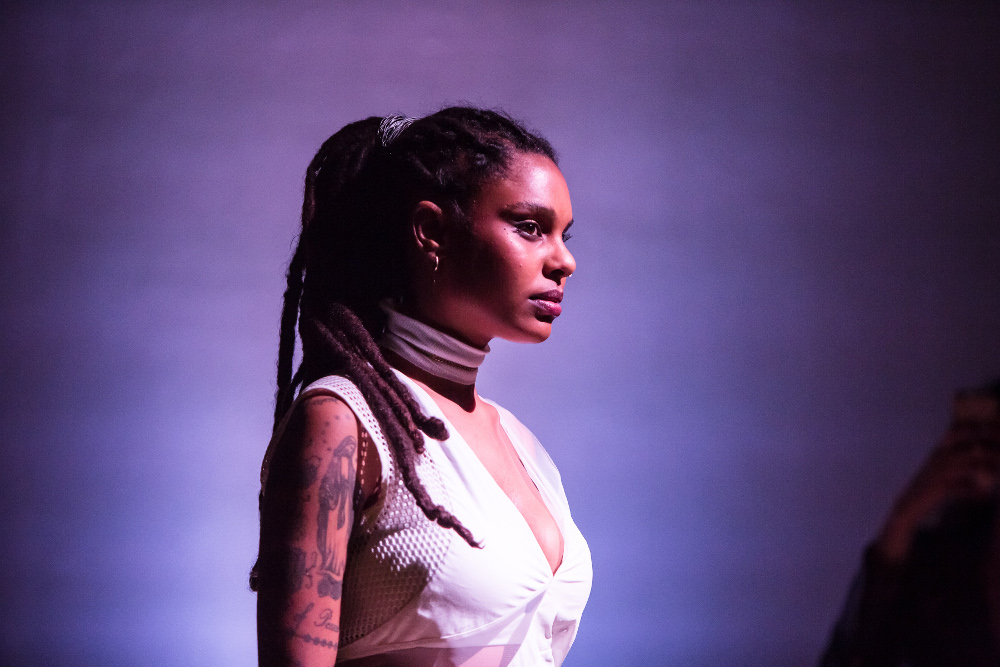Performa 2016 Gala
Last week South African artist Athi-Patra Ruga performed at a Gala event in New York, held to honour curator and writer Okwui Enwezor and to introduce the theme for next year’s Performa 17 Biennale, Beloved Country. Performa 17, which begins in November 2017, is the biggest and most anticipated performance art fair in the world and last week’s one night only show saw the cream of the international art world’s crop including curator Okwui Enwezor, artist Carrie Mae Weems, curator and art dealer Jeffrey Deitch, artist and photographer Cindy Sherman in attendance.
For Ruga’s piece, a procession of “choristers” and brass band members, which included rapper Dope Saint Jude and artist Angel–H0 dressed in religious white robes, hats and golden gloves marched and sang in step formation led by a duo holding one of Ruga’s tapestries. The performance culminated with spiritual iteration of Makubenjalo, the devastating finale of the original ending to Nkosi Sikel’iAfrika, with performers’ fists in the air. The New York Times’ Hilary Moss described the performance as ‘‘beyond brilliant’’. Ruga spoke to the Mail & Guardian after the performance.

The performance culminated into a Negro spiritual iteration of Makubenjalo, the devastating finale of the original ending to Nkosi Sikel’iAfrika, with performers’ fists in the air.
The performance titled Over the Rainbow had American media gushing over the artist who was dressed in a golden robe conjuring the spirits of Prince, Sun Ra, Medusa and the fourth force named The Versatile Queen Ivy.
The Mail & Guardian spoke to Ruga after the performance
Is this your first Performa performance?
This is my second Performa commission. My first was a production that I put together entitled Ilulwane (a tribute to all the boys who die in the Eastern Cape from ukwaluka and those who survive with castrations).
This was in 2011. My relationship with the organisation stretches back to the day I met Roselee Goldberg, the founder and a fellow South African. This was in Johannesburg during the anti-African xenophobic shutdown of ’08. I was then approached at the beginning of the year to kick of the programme for the 2017 biennial, which focuses on investigating the arts of South Africa and of course the diaspora.
What happened last night?
The purpose of the evening was to honour an icon in African contemporary art, Mr Okwui Enwezor and celebrate post-apartheid art production from home. I was commissioned to not only do a performance but to craft the evening’s “look” and feel. We then presented our piece titled Over the Rainbow, which was an emotive procession and concluded with a finale that debuted our new avatar, The Versatile Queen Ivy.
Carrie Mae Weems, Cindy Sherman in one room looking at you … What is currently going through your mind about yesterday?
To have been in a room where the front audience were literally icons of the industry, people who inspire me to get to studio and whose inspiration gives me the stamina I pride my studio in … yho … was just a moment that left me humbled and thankful to my ancestors (especially my mother who I last saw in 2003) for getting me there.
Over the Rainbow looked like an ascension into the ether. What was the basic concept behind a performance that fuses art, religion, fashion, music, theatre and politics?
The title alludes to the “Rainbow Nation”, a name bestowed on post-Apartheid South Africa by archbishop Desmond Tutu. I made a work that celebrates the hopefulness of the post-Apartheid era while also making references to the Wizard of Oz, Camp/Alternative marchers, Xhosa choral tradition and the existing racial tensions that might be “sugar coated” by “rainbowism” in lieu of true societal transformation.

My performance introduced NYC to the next generation of artists (Angel_Ho, Dope Saint Jude and Vuyo Sotashe) coming up in South Africa and will culminate in a show-stopping musical and video revue of influences and key South African cultural and musical movements including the emergence of kwaito, guz music, gqom and the participatory political chants and songs of umzabalazo (freedom songs) from the apartheid and “Must Fall” eras.
American media is certified bananas over you. What can artists from the global South teach the North?
My responsibility is not to teach per se, but to encourage the audience to rise to the occasion and to feel a self-confidence to soak in the work and then it’s up to them to consult Google and find out the genesis of the piece. This encourages a flow of conversation instead of a didactic framework that disempowers them ultimately.
Who are those gorgeous collaborators in the procession?
Angelo is the youngest, born two weeks before the 1994 elections in South Africa. He doesn’t have that much of an emotional connection to the euphoria of that event, therefore he has a perspective that is reflective of his generation … which has finally broken the spell of the new South Africa.
And this is reflected in the unprecedented student revolution that is the Fees Must Fall movement that aims at a total decolonisation of how art education is conceptualised and how that informs our respective audience. Something my generation never thought of approaching.
Dope Saint Jude is a queer woman who does not prescribe to the image and notion of victimhood, specifically that of patriarchy (a problem that is global). She was born in 1990, shortly after the release of Nelson Mandela and the unbanning of the opposition in SA.

This also gives fire to her practice which is an intersectional expression of hip hop and social commentary on topics ranging from gender equality to class struggles. Vuyo Sotashe, a Fulbright scholar from eGcuwa (Butterworth), is representative of the diasporan reach of South African excellence.
He embodies to me the optimism and excellence we all are manifesting tonight. And I am born in 1984, 10 years before “the freedom”. I remember voting day and was part of the national body that once reached and posed new challenges…and this is also where the metaphor of the “rainbow arch” narrative derives its soul.
Wednesday’s performance was a commission for the Performa 2016 Gala, Beloved Country. The Performa 17 programme starts in November 2017.